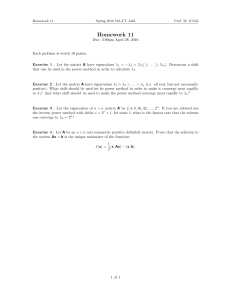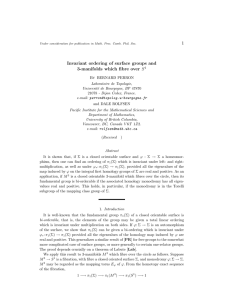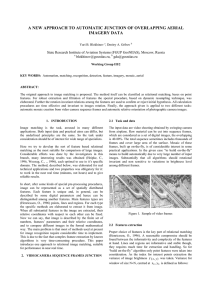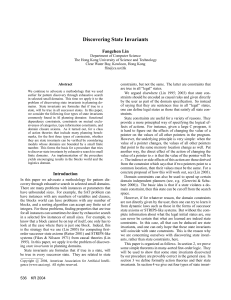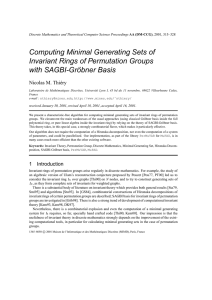XVII. CIRCUIT THEORY B. L. Diamond
advertisement
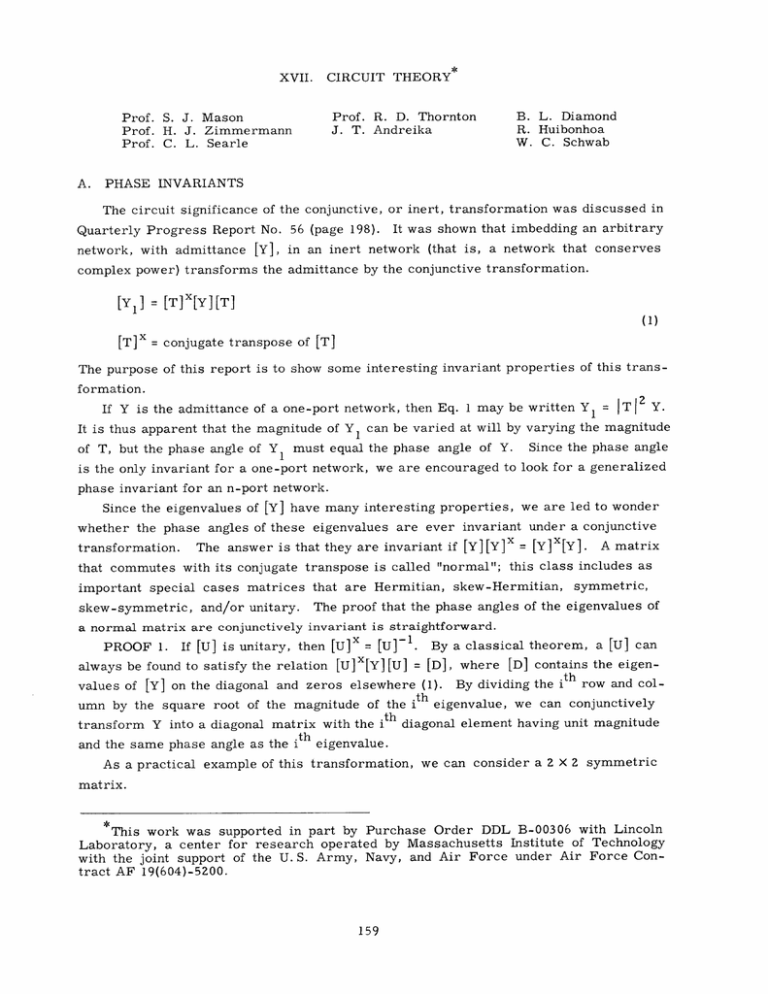
CIRCUIT THEORY XVII. A. B. L. Diamond R. Huibonhoa W. C. Schwab Prof. R. D. Thornton J. T. Andreika Prof. S. J. Mason Prof. H. J. Zimmermann Prof. C. L. Searle PHASE INVARIANTS The circuit significance of the conjunctive, or inert, transformation was discussed in Quarterly Progress Report No. network, with admittance [Y], 56 (page 198). It was shown that imbedding an arbitrary in an inert network (that is, a network that conserves complex power) transforms the admittance by the conjunctive transformation. [Y1] = [T]x[Y][T] (1) [T]X = conjugate transpose of [T] The purpose of this report is to show some interesting invariant properties of this transformation. If Y is the admittance of a one-port network, then Eq. 1 may be written Y 1 = IT 2 Y. It is thus apparent that the magnitude of Y1 can be varied at will by varying the magnitude of T, but the phase angle of Y1 must equal the phase angle of Y. Since the phase angle is the only invariant for a one-port network, we are encouraged to look for a generalized phase invariant for an n-port network. Since the eigenvalues of [Y] have many interesting properties, we are led to wonder whether the phase angles of these eigenvalues are ever invariant under a conjunctive The answer is that they are invariant if [Y][Y]X = [Y]X[y]. transformation. A matrix that commutes with its conjugate transpose is called "normal"; this class includes as important special cases matrices that are Hermitian, skew-symmetric, and/or unitary. skew-Hermitian, symmetric, The proof that the phase angles of the eigenvalues of a normal matrix are conjunctively invariant is straightforward. PROOF 1. If [U] is unitary, then [U]x = [U] - 1 . By a classical theorem, a [U] can always be found to satisfy the relation [U]x[Y] [U] = [D], where [D] contains the eigen- row and colBy dividing the i values of [Y] on the diagonal and zeros elsewhere (1). .th eigenvalue, we can conjunctively umn by the square root of the magnitude of the 1 th diagonal element having unit magnitude transform Y into a diagonal matrix with the i .th eigenvalue. and the same phase angle as the i As a practical example of this transformation, we can consider a 2 X 2 symmetric matrix. *This work was supported in part by Purchase Order DDL B-00306 with Lincoln Laboratory, a center for research operated by Massachusetts Institute of Technology with the joint support of the U.S. Army, Navy, and Air Force under Air Force Contract AF 19(604)-5200. 159 (XVII. CIRCUIT THEORY) = Let [Y] ] [Y1 x [T]x[Y][T] = 1; wz If [T] = ;x with x, y chosen to satisfy relations w xxz Iz 2 y ax + b(l+xy) + cy = 0 aXx + bx(1+xy) + cxy = 0 and w I2- = ax 12+b(x+xx)+c z 1-2 = la+b(y+yX)+c yYl2 0 1/2 ; A, B = eigenvalues of [Y] = then [Y a c 2 + b 0 IB Since most nonsymmetric admittance matrices are not normal, we need to find a more general phase invariant. the phase angle of a scalar. y = exp(a+jp); 1 One approach is by analogy with the procedure for finding If y is a scalar, we can write yx = exp(a-jp); yx, I = exp(-a+jp) x,-l Thus 22j In (yyX') = P ± nr, with n an integer. Except for the ambiguity of nTr, we can X-x,determine P3 from yyx,. We might expect that the eigenvalues of [Y][Y]x,-1 are invariant and could be interpreted as exp(2jpi), where the ants. Pi are the generalized phase invari- The proof that the eigenvalues of [Y] [Yx, -1 are invariant is relatively simple. PROOF 2. If [Y 1] = [T]X[Yo][T] then [Y1][Y1]X-I Hence ev[Y][Y [Yo] x,-1 [T]x,-1 = [T]X[Y x, -1 )= ev([Yo] [Yox ' -l ) x, -l For the scalar phase relation, yy number. that In the matrix relation, however, always has unit magnitude so that P is a real 3 may also occur in conjugate pairs. A proof p must be real or occur in conjugate pairs follows. 160 (XVII. x, -1 = ev[Y]X'-l[Y] = ev[Y][Y] (ev[Y]Y]X' -l)x, -1 = ev([Y][Y]x'- PROOF 3. x ' -1 then there must be a Pk that satisfies the = eviY][YY]x -, if e Hence, CIRCUIT THEORY) relation = and thus p (ejpx x = = evk[YY] ek x' - must be real or occur in conjugate pairs. One possible interpretation for a complex phase invariant can be deduced from an example. Let jejp; [Y] = -e - a 0 (2) jeJ 0 -ea [y]x,-1 0 a e [Y][Yy]x-1 -02 a zIn ej2; =13 ± ja ± (ev[Y] [Y])x n The network described by [Y] in Eq. 2 has the property that if it is terminated by equal source and load -aimpedances with phase angles in one direction and e in the other. 3, then the voltage gain will be ea Thus the imaginary part of the phase invariants is related to the gain of nonreciprocal networks. P3± The conjugate-pair phase invariants, ja, for a two-port network can be calculated as follows: ; ev[Y][Y]X' -1 = (cosh 2a ± sinh Za) ej2p If [Y] = where Ib 2 + Ic12 - (adx+axd) ; cosh 2a = cos 2P = Re (ad-bc) (3) Jlad-bc 2 ad-bc If cosh Za in Eq. 3 is less than unity, then the phase invariants are both real. Defining we find that these real invariants as P 1 and P2 (adx+axd)- _b cos ( 2 2 - Re (ad-bc) c12 ad)= bc 2 lad-bc I cos (1+2) ad-bc ad-bc The eigenvalues of [Y][Y]X -1 alone do not represent a complete set of invariants, and other methods must be used to determine completely a canonic form for Y. The problem of developing a complete and simple canonic form has not been fully solved. R. D. Thornton 161







